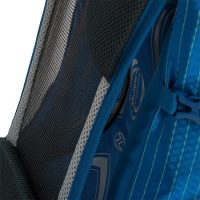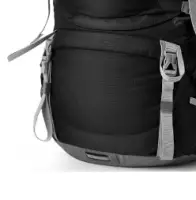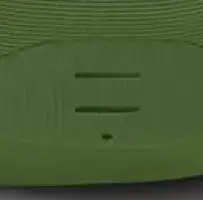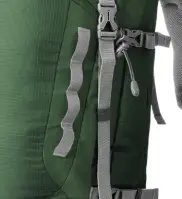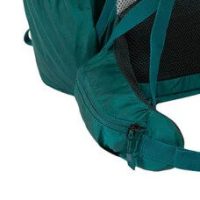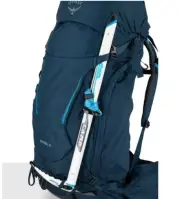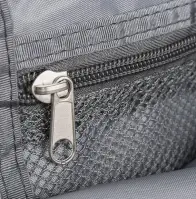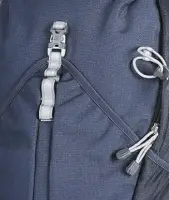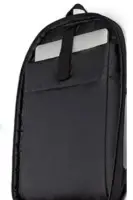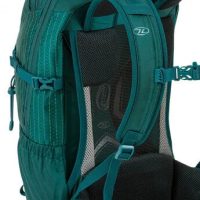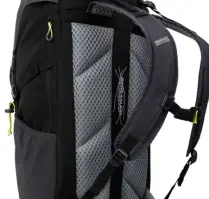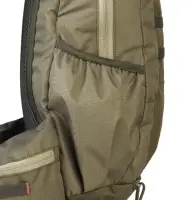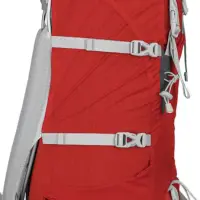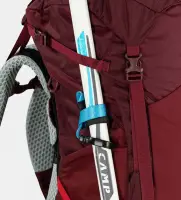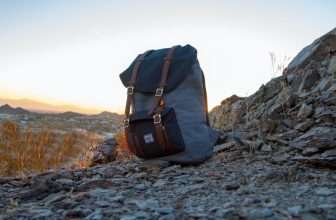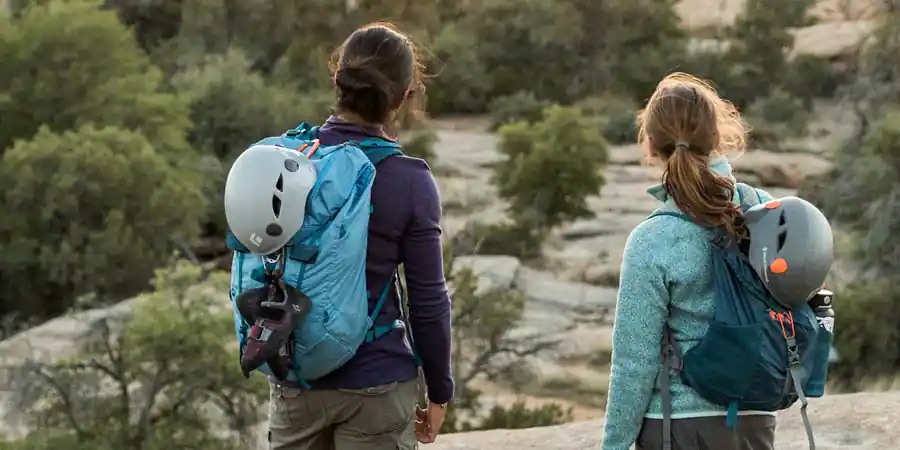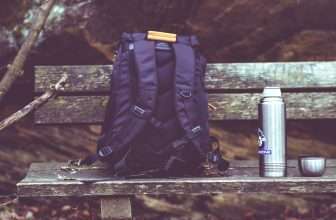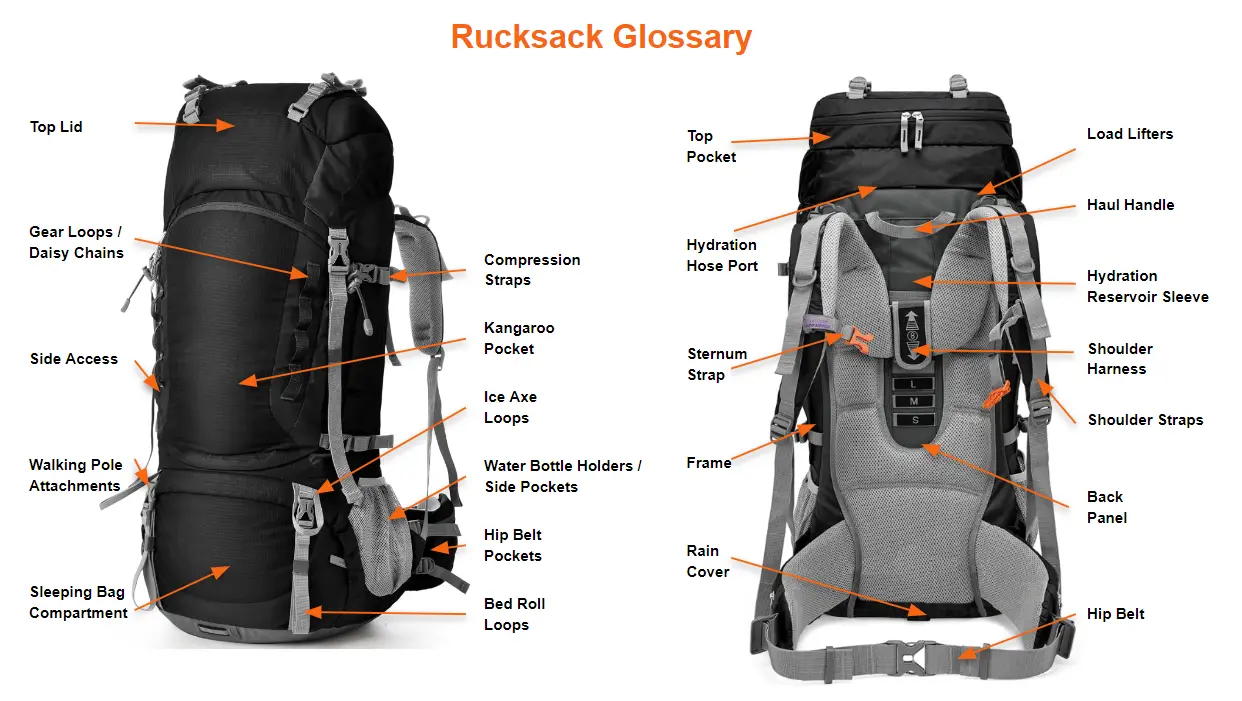
Contents
Toggle
Introduction
When it comes to selecting the perfect rucksack for your outdoor adventures, whether you’re hiking through the Lake District, commuting through bustling city streets, or embarking on a weekend camping trip, understanding the various features available is crucial on a rucksack. A well-chosen rucksack can make the difference between a comfortable, enjoyable experience and a challenging one. This rucksack glossary is designed to help you navigate the myriad of features available on rucksacks these days, ensuring that you choose a rucksack, backback or daypack tailored to your specific needs.
The UK’s diverse and often unpredictable weather, combined with the varied terrain encountered in the countryside, places unique demands on outdoor gear. From waterproof fabric to hip belts, every feature serves a specific purpose, contributing to the overall functionality and comfort of your rucksack. However, not all rucksack features are necessary for every user. For instance, a hiker tackling the peaks of Snowdonia might prioritize waterproofing and ripstop fabric, while a daily commuter may place more value on a laptop pocket and organizer compartments.
This rucksack glossary and guide will walk you through each feature, and where it is located on the rucksack, explaining its purpose, benefits, and potential drawbacks. Whether you’re an experienced climber, a weekend walker, or someone simply looking for a reliable pack for daily use, understanding these features will empower you to make an informed decision, ensuring your chosen rucksack meets your needs and stands the test of time.
Anatomy of a Rucksack - Front
Anatomy of a Rucksack - Rear
Why Should You Understand Rucksack Anatomy?
When choosing a rucksack, its size, shape, and features directly affect your comfort and how well the pack meets your needs. Knowing the anatomy of a rucksack helps in selecting the right pack, making adjustments for optimal fit, and packing efficiently. Here are several reasons why understanding rucksack anatomy is beneficial:
Optimal Comfort: The design and layout of a rucksack’s components, such as the back panel, shoulder straps, and hip belt, can make a huge difference in how comfortable the pack is when worn over long distances. A poor fit could lead to muscle strain or even injury.
Efficient Packing: Knowing the function of different compartments and pockets allows for organized packing, ensuring that important items are easily accessible. For example, certain compartments are better suited for water bottles, while others may be designed for sleeping bags.
Weight Distribution: A well-designed rucksack with an effective load-carrying system (like a proper hip belt and adjustable back length) helps distribute weight evenly across your body, reducing the risk of fatigue and improving balance.
Durability and Functionality: High-quality rucksacks come with durable materials, rain covers, and specific compartments or attachment points for items like walking poles, water bottles, or ice axes. Understanding these terms helps you choose a rucksack with the features you need for the conditions you’ll be facing.
Rucksack Glossary
Kangaroo Pocket
- Purpose: Front pocket with quick and easy access with no zips or faff.
- Benefit: Essential for storing maps, snacks or waterproof jacket for fast access.
- Negative Impact: Not secure or weatherproof. Items may fall out.
Metal Framework Back Support
- Purpose: Provides structure to the pack and aids in weight distribution.
- Benefit: Essential for carrying heavy loads over long distances.
- Negative Impact: Increases the weight and rigidity of the pack.
Quick Access Side Pockets
- Purpose: Allows easy access to water bottles or snacks.
- Benefit: Convenient for hydration and nutrition without removing the pack.
- Negative Impact: Items can fall out if pockets aren’t secure
Ripstop Fabric
- Purpose: Prevents small tears from spreading to the next square.
- Benefit: Increases the durability of the pack, essential for rough outdoor use.
- Negative Impact: Might be slightly heavier or more expensive than non ripstop alternatives.
Top Zippered Pocket
- Purpose: Provides quick access to frequently used items.
- Benefit: Convenient for storing small essentials like maps or snacks.
- Negative Impact: Can be a security risk if the zipper fails.
Waterproof Fabric
- Purpose: Protects contents from rain and wet conditions.
- Benefit: Essential for keeping gear dry in unpredictable UK weather.
- Negative Impact: Can add weight and reduce breathability.
Conclusion
Understanding the anatomy of a rucksack and the associated terminology is key to choosing the right pack for your outdoor adventures.
Whether you’re preparing for a short day hike or an extended camping trip, knowing how to adjust and use each component can improve comfort, help you pack more efficiently, and reduce the risk of injury.
By familiarizing yourself with terms like “hip belt,” “load lifters,” and “compression straps,” you can make informed decisions and get the most out of your rucksack.
Further more, selecting the right rucksack and understanding how to use it effectively will elevate your outdoor experiences, ensuring that you stay comfortable and well-prepared for whatever nature throws your way.
Whether you need a rucksack that can withstand unpredictable weather, provide comfort on long hikes, or simply offer practical storage solutions for your daily commute, understanding what each feature offers is key to finding the perfect match.
A well-chosen rucksack not only meets your immediate needs but also adapts to the changing demands of your adventures, ensuring that you’re always prepared, no matter where your journey takes you.
Key Questions About Rucksack Anatomy and Terminology
We have had a lot of questions about rucksack terminology and anatomy from people trying to choose the best rucksack. Here are some we have had with our answers.
1. What is the difference between a rucksack and a backpack?
In the UK, the term “rucksack” is often used interchangeably with “backpack.” However, traditionally, a rucksack refers to a larger pack designed for outdoor activities like hiking or camping, with more technical features and the ability to carry heavier loads. A “backpack” can refer to a smaller, less specialized bag used for casual purposes like commuting or school.
2. What is a back panel, and why is it important?
The back panel is the section of the rucksack that rests against your back. Its design is critical for comfort and airflow. Some back panels feature mesh suspension systems that keep the pack slightly raised off your back, allowing for better ventilation. Others have foam padding to provide support while conforming to the shape of your back. An ergonomically designed back panel reduces sweating and prevents discomfort on long hikes.
3. What is a frame, and what are the differences between internal and external frames?
The frame provides structure to the rucksack, helping to distribute the weight of the load evenly. There are two main types of frames:
Internal Frame: Most modern rucksacks have internal frames, which are hidden within the fabric. They provide a sleek and close-to-body fit, improving balance and mobility, especially on uneven terrain.
External Frame: External frames are less common but can be found on larger expedition packs. These frames are visible on the outside of the rucksack and are useful for carrying very heavy loads, as they offer excellent weight distribution and ventilation.
4. What is a hip belt, and why is it so important?
The hip belt is a padded strap that wraps around your hips and helps to transfer the weight of the pack from your shoulders to your hips, which are better suited for bearing heavy loads. A good hip belt is essential for maintaining balance and comfort, particularly on long treks. Many modern rucksacks also feature pockets on the hip belt for easy access to small items like snacks or a phone.
5. What are shoulder straps, and how should they be adjusted?
Shoulder straps should be wide, padded, and adjustable to ensure a snug fit. They play a key role in stabilizing the rucksack and helping to distribute weight. The straps should be tightened just enough to keep the rucksack close to your back without pulling all the weight onto your shoulders.
6. What are load lifters, and how do they work?
Load lifters are small straps found near the top of the shoulder straps. Their purpose is to pull the rucksack closer to your upper back, improving weight distribution and stability. Adjusting load lifters correctly can reduce shoulder strain and make the pack feel lighter by transferring more weight to the hip belt.
7. What is the top lid, and what should you store in it?
The top lid, also known as a “brain,” is a flap that covers the main compartment of the rucksack. Some top lids are removable and can double as a small daypack. It’s ideal for storing items you need quick access to, such as maps, a headlamp, or snacks.
8. What is the sternum strap for?
The sternum strap is a small strap that connects the two shoulder straps across your chest. Its purpose is to help stabilize the shoulder straps and prevent them from slipping off your shoulders. It also ensures that the weight of the pack stays centred, enhancing balance.
9. What is a hydration bladder sleeve?
A hydration bladder sleeve is a compartment inside the rucksack designed to hold a water reservoir (bladder). It often has an opening for a drinking tube, allowing hikers to stay hydrated without needing to stop and remove their pack. This feature is especially important for long hikes or multi-day treks.
10. What are daisy chains and gear loops used for?
Daisy chains are a series of loops sewn onto the exterior of the rucksack. They allow you to attach additional gear like carabiners, walking poles, or ice axes. Gear loops serve a similar function but are often more rigid and located on specific parts of the pack for optimal weight distribution.
11. What are compression straps, and when should they be used?
Compression straps are adjustable straps located on the sides of a rucksack. Their primary purpose is to reduce the volume of the pack when it’s not fully loaded, preventing the contents from shifting around. They can also be used to attach bulky items like sleeping pads to the outside of the pack.
12. What is the main compartment, and how should it be packed?
The main compartment is the largest section of the rucksack. Packing it correctly is key to maintaining balance and comfort. Heavier items should be packed closest to your back, while lighter items can go toward the front or bottom of the pack. Organizing items in stuff sacks can help keep everything in order.
13. What are rain covers, and why are they important?
A rain cover is an essential accessory for any rucksack, especially in the UK where weather conditions can change rapidly. Some rucksacks come with an integrated rain cover stored in a hidden pocket, while others require you to purchase one separately. A rain cover helps keep your gear dry, preventing water from seeping into the pack.




